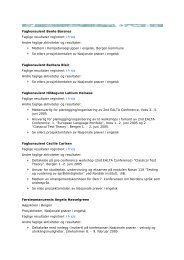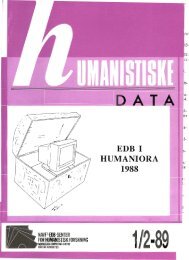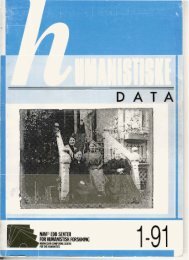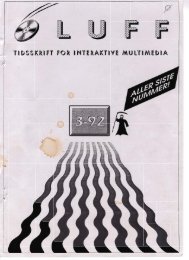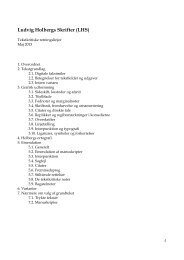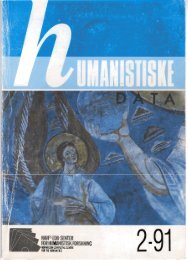Measuring corpus homogeneity using a range of measures for inter ...
Measuring corpus homogeneity using a range of measures for inter ...
Measuring corpus homogeneity using a range of measures for inter ...
Create successful ePaper yourself
Turn your PDF publications into a flip-book with our unique Google optimized e-Paper software.
<strong>corpus</strong> <strong>homogeneity</strong> within the different parts <strong>of</strong> a <strong>corpus</strong>.<br />
Their supervised approach is similar to Biber’s work on text<br />
classification, but they use a tagger/parser to analyze syntactic<br />
features.<br />
We present a technique <strong>for</strong> <strong>corpus</strong> analysis strictly<br />
based on <strong>inter</strong>nal features and unsupervised learning techniques,<br />
together with a set <strong>of</strong> <strong>measures</strong> <strong>for</strong> <strong>corpus</strong> <strong>homogeneity</strong><br />
and similarity.<br />
3. The methodology<br />
We propose a stochastic method to describe and compare<br />
corpora, which is based only on their <strong>inter</strong>nal features.<br />
This method can be computed <strong>for</strong> any <strong>corpus</strong>, and is independent<br />
<strong>of</strong> any particular theory <strong>of</strong> language: it uses all the<br />
linguistic features <strong>of</strong> the documents, and not just a special<br />
sub-set as <strong>for</strong> example in Biber’s work. The method has<br />
four steps:<br />
1. choose the aspect you want to study and the type <strong>of</strong><br />
feature you want to use;<br />
2. collect data <strong>for</strong> each document in the <strong>corpus</strong>;<br />
3. calculate the similarity between each pair <strong>of</strong> documents;<br />
4. quantify the characteristics <strong>of</strong> the <strong>corpus</strong>: we produce<br />
both a description <strong>of</strong> the <strong>corpus</strong> and <strong>measures</strong> <strong>of</strong> its<br />
<strong>homogeneity</strong> and its similarity in relation to other corpora.<br />
3.1. Deciding aspect and feature types<br />
Corpus pr<strong>of</strong>iling can be studied from different perspectives.<br />
As has been said, we restrict our <strong>inter</strong>est to linguistic<br />
analysis and in particular to the lexical, syntactic and semantic<br />
aspects. Each aspect can be studied <strong>using</strong> different<br />
feature types (i.e. words or POS tags). At the moment just<br />
the lexical and syntactic aspects have been investigated.<br />
Lexical analysis is per<strong>for</strong>med to detect possible restrictions<br />
in the vocabulary. As feature types <strong>for</strong> lexical analysis,<br />
either all-words or content words or lemmas are used.<br />
To identify restrictions at the syntactic level, either function<br />
words or POS tags or POS bi-grams are used. To detect<br />
function words a list <strong>of</strong> function words is needed, while to<br />
produce POS tag and POS bi-gram frequency lists a POS<br />
tagger is required.<br />
3.2. Collecting the data<br />
The objects employed to study <strong>corpus</strong> pr<strong>of</strong>iling are the<br />
texts that make up the <strong>corpus</strong>. Each text is represented by<br />
a vector <strong>of</strong> features (attributes) or a frequency list. A frequency<br />
list is a list <strong>of</strong> pairs ¢¡¤£¦¥¨§©¡���� in which ¡ is a feature<br />
instance, e.g., the function word “with” or the lemma<br />
“to cut”, and ¥¨§©¡�� is the frequency <strong>of</strong> the feature ¡ in the<br />
document (the number <strong>of</strong> occurrences <strong>of</strong> “with” or “to cut”<br />
in the document). Instead <strong>of</strong> <strong>using</strong> the sample<br />
¥¨§©¡��<br />
frequency<br />
direcly, we compute the estimate <strong>of</strong> the probability<br />
§©¡�� . �<br />
This step yields a matrix which represents a <strong>corpus</strong> by<br />
the frequency lists <strong>of</strong> its documents.<br />
3.3. Computing similarity<br />
Probability lists representing texts in the <strong>corpus</strong> can also<br />
be seen as distributions. Two documents are considered<br />
similar if their probability distributions are similar. We explored<br />
the use <strong>of</strong> three different text-similarity <strong>measures</strong>.<br />
Relative entropy, also know as Kullback-Leibler divergence,<br />
is a well-known measure <strong>for</strong> calculating how similar<br />
two probability distributions are (over the same event<br />
space). If � §©��� and � §©��� are the distributions which represent<br />
two documents, the relative entropy, � § �¨� � � � , is calculated<br />
as follow:<br />
§ �¨� � � ����� ��<br />
�<br />
���<br />
§©��������� � §©���<br />
� §©��� �<br />
Because it is not defined <strong>for</strong> � §©������� , <strong>for</strong> which<br />
� § �¨� � � ����� , we compute the centroid, the average probability<br />
distribution <strong>of</strong> the <strong>corpus</strong>, and then add it to each<br />
distribution be<strong>for</strong>e calculating the similarity. The <strong>for</strong>mula<br />
<strong>for</strong> relative entropy becomes:<br />
§ �¨� � � ����� ��<br />
���<br />
���<br />
� §©���¤����§©����������� � §©��������§©���<br />
§<br />
§©��������§©��� �<br />
with ��§©��� the centroid <strong>of</strong> the entire <strong>corpus</strong>.<br />
We also tested two other similarity <strong>measures</strong> based on<br />
the divergence from the null hypothesis that the two documents<br />
are random samples from the same distribution: Chi<br />
Squared and Log-likelihood.<br />
Chi Square measure (�¨� ): <strong>for</strong> each feature in the frequency<br />
list, we calculate the number <strong>of</strong> occurrences in each<br />
document that would be expected. Suppose the sizes <strong>of</strong><br />
documents A and B are respectively ��� and ��� and feature<br />
w has observed frequency ����� � in A and ����� � in B,<br />
then the expected value � ��� � <strong>for</strong> A is:<br />
��� � � ��� §������ � ������� � �<br />
��� � ���<br />
�<br />
and likewise � ��� � <strong>for</strong> <strong>for</strong> document B. Then �¨� the value<br />
<strong>for</strong> the document pair, A and B, is computed as follows:<br />
� ��� ��<br />
�<br />
���<br />
§��<br />
��� �<br />
� �<br />
�<br />
�<br />
�<br />
with the sum over all the features.<br />
(��� Log-likelihood ): Dunning (1993) showed ��� that<br />
is a much better approximation <strong>of</strong> the binomial distribution<br />
��� than especially <strong>for</strong> events with frequencies smaller than<br />
5. It is a measure that works quite well with both large and<br />
small documents and allows the comparison <strong>of</strong> the significance<br />
<strong>of</strong> both common and rare events. A Contingency<br />
table, as presented in table 1, helps us to understand the<br />
<strong>for</strong>mula ��� <strong>for</strong> .<br />
� � � � �<br />
����§����¤�¢��� ����§����¤����� ����§����¤����� ����§����<br />
�<br />
�<br />
§����<br />
�<br />
����§����¢��� �<br />
§����¢�����<br />
����§�������� §����������<br />
����§�������� §����������<br />
����§�������� §����������<br />
��§����¢������������� ����§����¢�����������




